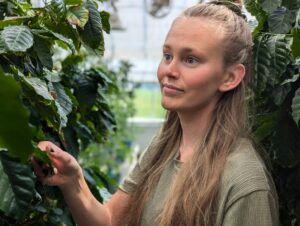Written by: Matilda Bergsten, Jander Lab REU Researcher

Bergsten examining coffee plants in the BTI greenhouse
Every day, millions of cups of coffee are consumed all around the world. It is a beverage that is an integral part of the daily routines of many different cultures.
Coffee isn’t just popular for its taste. Almost everyone knows someone who claims they need their morning coffee to kickstart their productivity. We may have also heard of students and shift workers who rely on coffee to stay alert and awake when they need it the most.
The sensation that many people seek when consuming these drinks is not only the flavor but also the desire for alertness and increased productivity. The reason we experience these sensations when drinking coffee is due to a well-known molecule called caffeine.
Although caffeine consumption may seem harmless and is highly normalized in our societies, it is actually considered a stimulant drug that increases the speed of messaging between the body and the brain. This results in the feeling of being more alert and active.
It might not be surprising to learn that caffeine also comes with some negative effects as well. Consumers may find that drinking coffee late in the evening can make it hard to fall asleep, while consuming an energy drink may lead to shaky hands and a racing heartbeat. The more we consume, the higher the possibility of experiencing these negative effects.
In high amounts, caffeine can be toxic and cause harm to our bodies. However, it is worth noting that these high amounts are hard to reach by consuming caffeinated beverages alone. But why can caffeine be harmful to us? We can uncover the answer by delving into the origins of caffeine and its intended function in nature.
Caffeine is not only found in coffee beans from the plant Coffee Arabica but also in the tea plant Camellia Sinensis. Why do we find the same molecule in two different plants? The answer is known as convergent evolution of identical metabolites. This may make more sense when considering the intended function of caffeine as a plant defense mechanism.
Plants and insects have evolved together through evolution and have had a constant arms race. Insects want to feed off plants, and the plants want to avoid being eaten. This has naturally caused the plants to create chemical defenses by evolving the ability to produce metabolites that are toxic or undesirable for the insects.
Caffeine is an example of this defense strategy and has evolved as a metabolite that is toxic and undesirable to insects, thus acting as the plant’s own insecticide. Since caffeine is an effective insecticide, it might not be surprising that two different plants adapted the same metabolite to protect themselves.
Another example of a plant defense metabolite that is commonly found in our society is nicotine. Nicotine, like caffeine, is considered a stimulant drug and is present in tobacco products such as cigarettes and chew tobacco.
Nicotine has evolved as a toxic defense metabolite in the tobacco plants Nicotiana rustica and Nicotiana tabacum to protect them against insects. Although we are not as negatively affected by the doses that insects are exposed to due to our larger size as a species, in sufficiently large doses, we also experience the toxic effects of this defensive compound.

Acknowledging the natural functions of these commonly found and consumed chemical compounds helps us realize that plants are more integrated into our lives than we might have initially thought and that we are more connected to nature than we might be aware of.
It’s a good reminder that the world doesn’t always revolve around us and our needs. Plants developed these compounds for their own benefit and protection rather than with the primary goal of enhancing human alertness and productivity.
So, the next time you drink your morning coffee, you can feel grateful for enjoying the chemical result of the ongoing battle between plants and insects and the ingenuity of evolution.
References:
Boaz Negin. Georg Jander. Convergent and divergent evolution of plant chemical defences. Current Opinion in Plant Biology. Volume 73. June 2023. 102368 https://www.sciencedirect.com/science/article/pii/S136952662300033X
ADF – Alcohol and Drug Foundation.
https://adf.org.au/drug-facts/caffeine/
https://adf.org.au/drug-facts/nicotine/#wheel
Lessons on Caffeine, Cannabis & Co, plant-derived drugs and their interactions with human receptors. Textbook. 2018. https://link.springer.com/book/10.1007/978-3-319-99546-5
